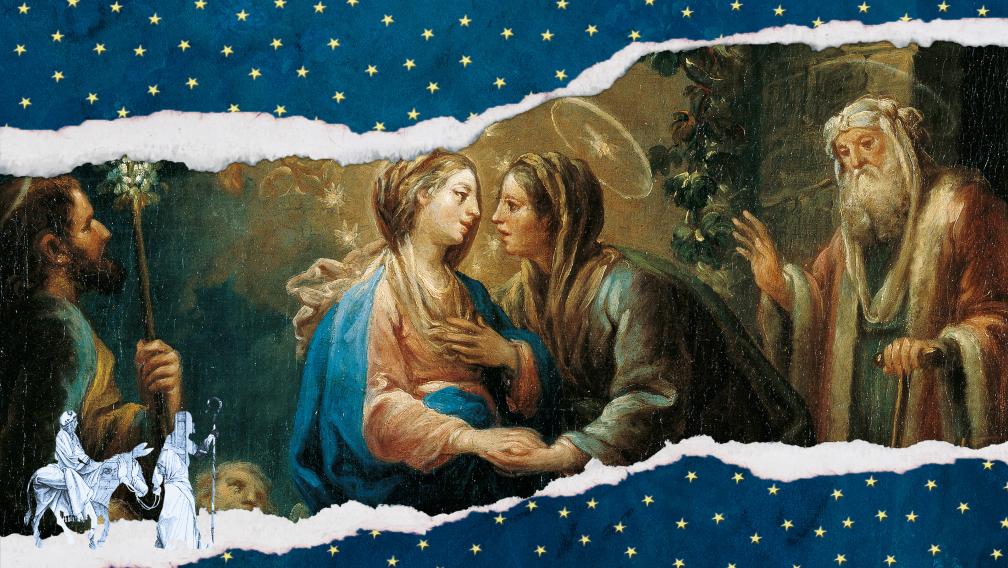How We Carry God’s Love Into the World

“For as soon as I heard the sound of your greeting, the child in my womb leaped for joy.” — Luke 1:44
To understand this week’s Gospel passage, we’ve got to take a step back and remember what comes before. The angel Gabriel visits Mary and announces the coming of the Son of God. Gabriel says this child is to be born to Mary in the lineage of the great King David and will bring into the world a new kingdom, an eternal reign of God. This seems impossible to Mary, particularly because she’s not yet married, but her answer to Gabriel is filled with courage: “Here I am, let it be with me according to your word.”
Now Mary is on the road visiting her cousin Elizabeth, who’s also miraculously with child. Upon hearing Mary’s greeting, Elizabeth recognizes immediately God at work in Mary. She is filled with the Holy Spirit and cries out in celebration: “Blessed is she who believed that there would be a fulfillment of what was spoken to her by the Lord.”
When we talk about Mary, we don’t usually take the time to listen to what she herself has to say. What we think we know about her is often based on our own opinions or other sources. Mary, writes author Elizabeth Johnson, has been “interpreted and explained, imagined and rejected, loved and honored in ways so diverse as to be impossible to codify.” Our assumptions do not always reflect Mary’s own words — her well-known response to Elizabeth’s celebration is now called the Magnificat, also known as the Song of Mary.
“My spirit rejoices in God my Savior,” she says, “for he has looked with favor on the lowly state of his servant. Surely from now on all generations will call me blessed, for the Mighty One has done great things for me, and holy is his name; indeed, his mercy is for those who fear him from generation to generation.”
Mary’s story is a message of God’s love at work in the world, encompassing every aspect of our lives and upending anything — politics, ethics, social structures, economics, and more — that stands in the way of justice.”
Mary shows us what extraordinary and truly marvelous things God can do when one is surrendered to God and receptive to God’s will. Mary’s total trust in her savior, who was also her son, is a celebration of faith, even and especially when things feel impossible. In choosing Mary as the bearer of God’s son, God makes a wise decision. And, likewise, Mary makes a bold choice in affirming God’s plan. Mary and Elizabeth model for us courageous acceptance and joyful recognition of God’s will in our lives.
The message of abundance in Mary’s story — that God is not limited by our understanding or way of doing things — is not just pious, religious sentiment; it is not merely about good feelings. It is a message of God’s love at work in the world, encompassing every aspect of our lives and upending anything — politics, ethics, social structures, economics, and more — that stands in the way of justice. For God has done, is doing, and will continue to do great things with and without our help.
On this fourth Sunday of Advent, we remember Mary and the unique role she played as the God-bearer whose relationship with God changed the course of human history. In celebrating Mary’s bold faith, let us trust that our own relationship with God — and our calling as God-bearers — can also change the world in ways beyond the limits of our imagination.
Read all of Sunday’s scriptures
Step Into the Story
Here are some ways to think about how we might follow Mary’s example and carry God’s love into the world today.
Poetry
In his sonnet “Hidden Joys,” Anglican priest and poet Ayodeji Malcolm Guite highlights how Mary and Elizabeth were disregarded as women, too young and too old, living on the margins, and yet they were “favoured of heaven.” Particularly striking is the way Guite names Elizabeth and Mary as prophets, not merely passive recipients of God’s grace.
Music
Singer-songwriter Patty Griffin’s “Mary” reflects the role that Mary played not just in birthing Jesus but also as the one who “moves behind” him in the aftermath of his suffering and death. As a mother, Mary stands in solidarity with all those who lose loved ones to injustice.
Film
This scene from The Nativity Story brings to life Mary’s time with Elizabeth. In it we see both the extraordinary nature of Elizabeth’s insight into Mary’s pregnancy as well as Mary’s entirely ordinary and quite reasonable anxieties about how Joseph and others will react to her situation, which Elizabeth does her best to allay.
Mother Yein is Priest and Associate Director, Sacramental Life and Membership, at Trinity Church.





